Saturdays, noon to 1 p.m. ET on WICR 88.7 FM.
Or listen live from anywhere on WICR Online!
Our call-in number during the show: (317) 788-3314

July 28, 2018
Wawasee and Maxinkuckee: resort lakes in northern Indiana
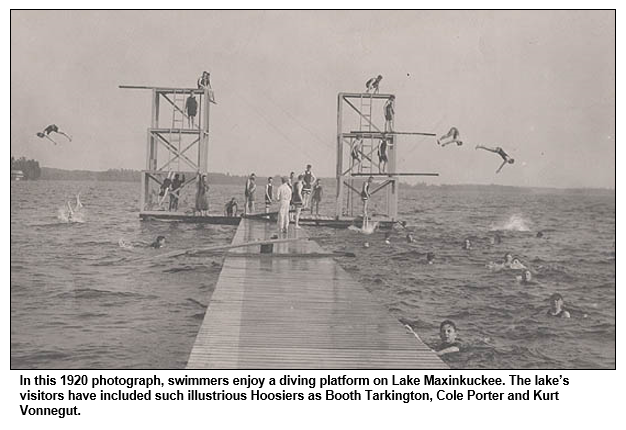
As the two largest natural lakes in Indiana, they have been the scenic locations of summer homes for more than 100 years, with vacation lodging options ranging from waterfront mansions to cottages and bungalows. They've also attracted their share of celebrities and even notorious characters.
Lake Wawasee, southeast of the town of Syracuse in Kosciusko County, and Lake Maxinkuckee - with the town of Culver (Marshall County) near its shores - share glacial origins along with most of the lakes of northern Indiana. (Lake Monroe in southern Indiana is larger than either of the two, but it is man-made.)
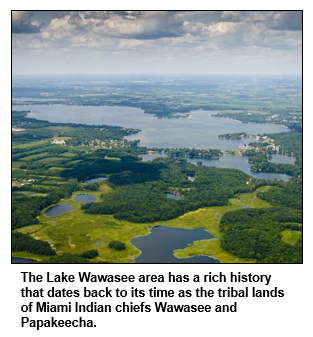
At Lake Maxinkuckee, several generations of the Vonnegut family from Indianapolis enjoyed summer homes. Reflecting on boyhood summers there, Kurt Vonnegut Jr. called the lake "my Aegean Sea" and "my Eden lost." Other famous Hoosiers, including composer Cole Porter and novelist Booth Tarkington, also visited friends or spent summers at Lake Maxinkuckee homes. Tarkington even wrote part of his first bestseller, The Gentleman from Indiana (1899), there.
Two Native American tribes lived along the shores of the lakes since at least the early 1800s.
 Miami Indians lived on the Lake Wawasee site that later became the location of the Spink Hotel. Potawatomi Indians lived at Lake Maxinkuckee, which occupies about 1,800 acres of spring-fed water and is 88 feet deep at its deepest point.
Miami Indians lived on the Lake Wawasee site that later became the location of the Spink Hotel. Potawatomi Indians lived at Lake Maxinkuckee, which occupies about 1,800 acres of spring-fed water and is 88 feet deep at its deepest point.
Two guests with lifelong involvements with the resort lakes will join Nelson in studio:
- Fort Wayne native Charles Braun, the attorney who hosts Legally Speaking, the WICR-FM call-in legal advice show, will share insights about Lake Wawasee. Over a span of nearly 100 years, five generations of the Braun family have rented or owned property on Lake Wawasee. For many years, Charles' mother owned a condo at the former Spink Hotel.
- And Culver native Jeff Kenney, the archives manager for the Culver Academies Museum, who regularly provides historical commentary on boat tours of Lake Maxinkuckee.

Culver Military Academy, the private, college-prep high school, is located at Lake Maxinkuckee, of course, but we will save the bulk of the school's history for a show down the road. We've got plenty to dive into with the resort lakes, where history continues to unfold. A cover story in this month's issue of Indianapolis Monthly magazine noted that at Lake Wawasee, the historic Oakwood Resort has recently reopened, reporting, "The 125-year-old lodge hosts a salon, spa and the Pier Restaurant , with a great view of Wawasee's many expensive boats."
Referring to Kurt Vonnegut's affection for Lake Maxinkuckee, the magazine notes: "The author couldn't have fabricated a more scenic locale in his novels . . . Indiana's second-largest natural body of water offers shoreline restaurants, well-lit trails and a small town full of boutiques."
According to our guest Jeff Kenney, the arrival of a railroad to Culver in 1884 "launched the plethora of summer cottagers who settled on the lake . . . bringing some 7,000 visitors from across the state to Maxinkuckee on any give summer weekend." Current owners of homes at Lake Maxinkuckee include Jim Irsay, the owner of the Indianapolis Colts, and a brother of Vice President Mike Pence.
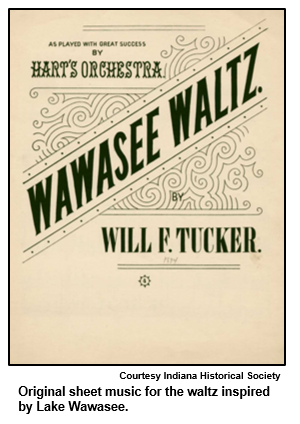
During our show, Charles also will discuss Syracuse Lake, which is near Wawasee and doesn't have as much of the larger lake's "abundant boat traffic," as Indianapolis Monthly puts it. The magazine refers to Syracuse Lake as "a quiet alternative."
Some history facts:
- Maxinkuckee ice was an export of the area in the days before modern refrigerators. "[It] was sold, thousands of tons of it, all over the Midwest from 1880 to 1937," Jeff Kenney says.
- A Hoosier who was among the survivors of the Titanic shipwreck in 1912 became the head gardener at Culver Military Academy.
- A musical composition called the Wawasee Waltz was written in the mid-1890s. The Syracuse Public Library and the Syracuse-Wawasee Historical Museum have posted a recording of the waltz online, along with period postcards of lakeside activities.
History Mystery
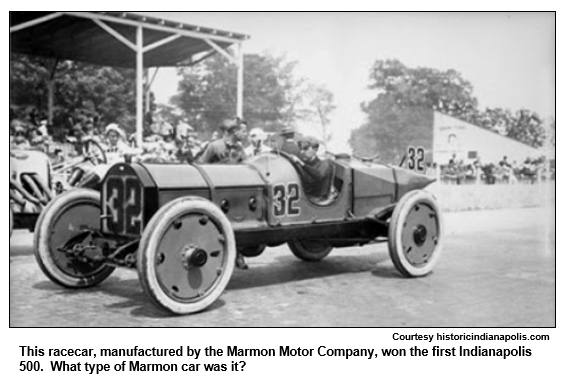
Influential families who owned cottages at Lake Maxinkuckee beginning in the late 1800s included the Marmons, the pioneering automobile makers. Howard Marmon founded the Indianapolis-based Marmon Motor Company, which built the winning car in the first Indianapolis 500 in 1911. By then, the Marmon family had enjoyed a cottage at Lake Maxinkuckee for more than 20 years.
Question: Name the type of Marmon car that won the inaugural Indy 500.
Hint: The car's name was derived from its color scheme.
The call-in number is (317) 788-3314. Please do not call in to the show until you hear Nelson pose the question on the air, and please do not try to win if you have won any other prize on WICR during the last two months. You must be willing to give your first name to our engineer, you must answer the question correctly on the air and you must be willing to give your mailing address to our engineer so we can mail the prize pack to you. The prize is a family four-pack admission ticket to Conner Prairie Interactive History Park, including passes for the Balloon Voyage ride, courtesy of Conner Prairie.
Roadtrip: the Dixie Sternwheeler and Lake Webster

Guest Roadtripper and historic preservationist Theresa Berghoff invites us to join her on the banks of beautiful Lake Webster, just south of Lake Wawasee in Kosciusko County. The object of our journey: the Dixie sternwheeler, the oldest sternwheeler in the state of Indiana. (For the nautically uninformed, a sternwheeler is a steamship propelled by a paddle wheel positioned at the rear.) Docked in the town of North Webster, the Dixie has plied the waters of Lake Webster for the better part of a century and was added to the National Register of Historic Places in 2009.
As Theresa explains, the Dixie is one of three sternwheelers that have served the Lake Webster community. The first was called the City of Webster, built by German immigrant Joseph Breeck in 1906. Captain Breeck was a blacksmith and former riverboat pilot. He used the boat as a floating blacksmith shop and also delivered mail and groceries in it. In 1913 the boat hit some rocks and sank.
Captain Breeck built a second boat, this time with a wooden hull; he called it the Dixie and offered Sunday tours around the lake. The wooden hull quickly deteriorated, however, and by 1928 it was beyond repair. The captain salvaged what he could, burned the remains and sank them in a deep-water area of the lake.
The current Dixie was built of the salvaged parts of the original Dixie and a new flat bottom steel hull that was shipped from St. Louis by rail. After 89 years in service, it would seem that the Dixie proves the old adage, "the third time's the charm," at least when it comes to Captain Breeck's boats.
To get to know the Dixie in her native element, Theresa encourages Hoosier History Live listeners to board the sternwheeler and take a cruise around Lake Webster, available from Memorial Day weekend to Labor Day weekend for only $7.
Prizes solicited for History Mystery contest
If your business or organization would like to contribute prizes for our History Mystery contest, we would love to have them! Ideally they fit in a standard mailing envelope, such as coupons or vouchers.
Your organization gets a mention on the air by Nelson, as well as a link to your website on our newsletter and website! If interested, contact producer Molly Head at molly@hoosierhistorylive.org.
Nelson Price, host and historian
Molly Head, producer/project manager, (317) 927-9101
Michael Armbruster, associate producer
Cheryl Lamb, administrative manager
Richard Sullivan, senior tech consultant
Pam Fraizer, graphic designer
Garry Chilluffo, special events consultant
Please tell our sponsors that you appreciate their support!

 Acknowledgments to Monomedia, Visit Indy, WICR-FM, Fraizer Designs, Heritage Photo & Research Services, Henri Pensis, Chris Shoulders, Aaron Duvall, and many other individuals and organizations. We are an independently produced program and are self-supporting through organizational sponsorship, and by individual contribution at the yellow button on our newsletter or website. For organizational sponsorship, which includes logos, links, and credits in the show, contact Molly Head at (317) 927-9101 or email her at molly@hoosierhistorylive.org. And any of our podcasts can be sponsored for a nominal fee.
Acknowledgments to Monomedia, Visit Indy, WICR-FM, Fraizer Designs, Heritage Photo & Research Services, Henri Pensis, Chris Shoulders, Aaron Duvall, and many other individuals and organizations. We are an independently produced program and are self-supporting through organizational sponsorship, and by individual contribution at the yellow button on our newsletter or website. For organizational sponsorship, which includes logos, links, and credits in the show, contact Molly Head at (317) 927-9101 or email her at molly@hoosierhistorylive.org. And any of our podcasts can be sponsored for a nominal fee.
Thank you!
We'd like to thank the following recent, new and renewal contributors whose donations help make this show possible!
- Dave and Theresa Berghoff
- Ann S. Frick
August 4, 2018 - Upcoming
Fort Wayne: riverfront heritage and historic building reuse

The state's second-largest city is located at the confluence of three waterways: the St. Joseph, St. Mary's and Maumee rivers. Against the backdrop of a vibrant revival of the downtown riverfront in Fort Wayne, we will explore the impact of the rivers on the city as well as current initiatives to reuse historic riverfront buildings.
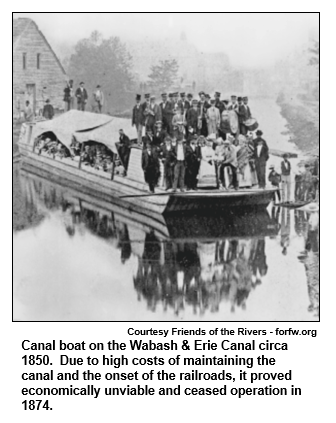
Recently, a replica of a 19th century canal boat, "Sweet Breeze," was launched for history tours about Fort Wayne's waterways . The canal era in Indiana was brief; the last boat on the Wabash & Erie Canal docked in 1874.
The name of the replica canal boat is a nod to the region's Native American history. Sweet Breeze was the daughter of Little Turtle (circa 1751-1812), the widely admired chief of the Miami Indians based in northeastern Indiana.
As our guides through Fort Wayne's riverfront history and the new ways it's being showcased - including the development of Promenade Park in the riverfront area - Nelson will be joined by two studio guests:
- Allen County historian Tom Castaldi, who writes a history column for Fort Wayne Monthly magazine and hosts "On the Heritage Trail" segments about local history for WBOI-FM Radio.
- And Fort Wayne historian Randy Harter, the owner of Fort Wayne Food Tours, which offers downtown walking tours exploring the city's history, architecture and food heritage. Randy also is the author of books including Legendary Locals of Fort Wayne (Arcadia Publishing, 2015) - fellow guest Tom Castaldi is among those profiled in it - and Fort Wayne Through Time, which will be published this fall.
"Summit City," the historic nickname for Fort Wayne, was derived from its canal heritage. The city was the highest point (or summit) on the Wabash & Erie Canal. Built by manual laborers as a way to transport goods and people, the canal linked the Great Lakes with other canals and, ultimately, the Ohio River.
For several years, the town of Delphi in Carroll County also has been showcasing its Wabash & Erie Canal heritage to visitors. Cruises on replicas of historic canal boats, with costumed reenactors as guides, are offered at the Wabash and Erie Canal Park in Delphi. Our guest Tom Castaldi helped plan and research displays at the park's canal museum.
In Fort Wayne, historic revitalization efforts underway include the revitalization of a stretch of Columbia Street in downtown Fort Wayne known as The Landing. In February, a major renovation project began there with the goal of reusing historic structures as restaurants, apartments, offices and retailers.
© 2018 Hoosier History Live. All rights reserved.
|






